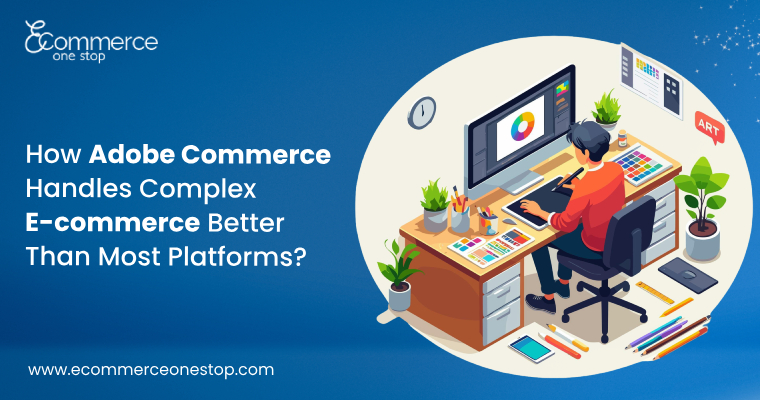The Global e-commerce sales are forecast to reach $6.56 trillion in 2025 (Oberlo). As e-commerce grows rapidly, businesses need platforms that can manage complex operations while delivering exceptional customer experiences. Adobe Commerce (formerly Magento Enterprise) is a leading solution designed for sophisticated online stores.
44.2% of USA e-commerce sales come from mobile devices in 2025 (Exploding Topics). Whether you’re running a global retail operation or a B2B business with unique needs, Adobe Commerce development services offer tools to succeed.
This blog explores why Adobe Commerce outperforms most platforms for complex e-commerce.
What is Adobe Commerce?
Adobe Commerce is a composable e-commerce platform that enables businesses to create global, multi-brand B2C and B2B experiences from a single cloud-native system. Built on the foundation of Magento, it was rebranded after Adobe’s 2018 acquisition.
It powers over 130,000 storefronts worldwide, holding an 8% share of the global e-commerce platform market and supporting over $150 billion in annual gross merchandise value (GMV. Its flexibility makes it a top choice for enterprises needing tailored solutions).
Why Adobe Commerce Excels for Complex E-commerce?
Complex e-commerce involves large product catalogs, multiple stores, international sales, or B2B operations. Adobe Commerce shines in these areas with features that set it apart.
Key Features of Adobe Commerce
- Scalability: Handles up to 250 million SKUs and processes over 200,000 orders per hour, perfect for high-traffic enterprises.
- Customization: An API-first approach allows businesses to tailor storefronts to specific needs, supported by a Magento development company.
- Integration Capabilities: Connects smoothly with Adobe Experience Cloud and third-party tools like CRMs and ERPs for unified operations.
- B2B and B2C Support: Offers features like corporate accounts, custom pricing, and quote negotiations for versatile business models.
- Performance: Optimized for fast response times using edge computing, ensuring smooth user experiences.
- Security: Enterprise-grade security protects sensitive data, critical for large-scale operations.
- AI-Powered Personalization: Uses AI to deliver personalized shopping experiences, boosting conversions.
Adobe Commerce’s Comparison with Other Platforms
| Feature | Adobe Commerce | Shopify | WooCommerce |
|---|---|---|---|
| Scalability | Supports 250M SKUs, 200K orders/hr | Limited for large catalogs | Requires plugins for scale |
| Customization | Extensive via APIs | Limited by templates | High but needs technical skills |
| B2B Features | Built-in, robust | Requires apps | Limited, plugin-dependent |
| Ease of Use | Requires technical expertise | User-friendly | Moderate, WordPress-based |
| Cost | Starts at $22,000/year | $39-$399/month | Free plugin, hosting costs vary |
Shopify is ideal for small to medium businesses due to its simplicity and lower cost, starting at $39/month. However, it may require additional apps for complex needs, increasing costs.
WooCommerce, a WordPress plugin, offers flexibility but lacks native enterprise features, often needing third-party extensions.
Adobe Commerce, supported by a Magento Enterprise development company, is built for complexity, making it the go-to for large-scale operations.
Conclusion
Adobe Commerce stands out for complex e-commerce due to its scalability, customization, and robust integrations. Unlike simpler platforms, it handles large catalogs, multi-store setups, and B2B needs with ease. Its AI-driven personalization and enterprise-grade security further enhance its appeal.
For businesses aiming to thrive in 2025’s competitive e-commerce landscape, partnering with an Adobe Commerce development company can unlock its full potential.
Ready to transform your online store? Connect with our expert team for top-tier Adobe Commerce development services to drive your business forward.
1. What is the difference between Adobe Commerce and Magento Open Source?
Adobe Commerce is the enterprise version with advanced features and support, while Magento Open Source is a free, community-driven platform with fewer capabilities.
2. Is Adobe Commerce suitable for small businesses?
It’s designed for enterprises, but small businesses with complex needs can benefit, though it requires more investment and technical expertise.
3. How does Adobe Commerce handle multi-language and multi-currency stores?
It supports multiple languages and currencies natively, simplifying management of international stores from one platform.
4. Can I integrate Adobe Commerce with my existing CRM or ERP system?
Yes, it offers robust integration with third-party systems like CRMs and ERPs, streamlining operations.
5, What kind of support does Adobe Commerce provide?
It includes comprehensive documentation, community forums, and dedicated enterprise support for smooth implementation.


